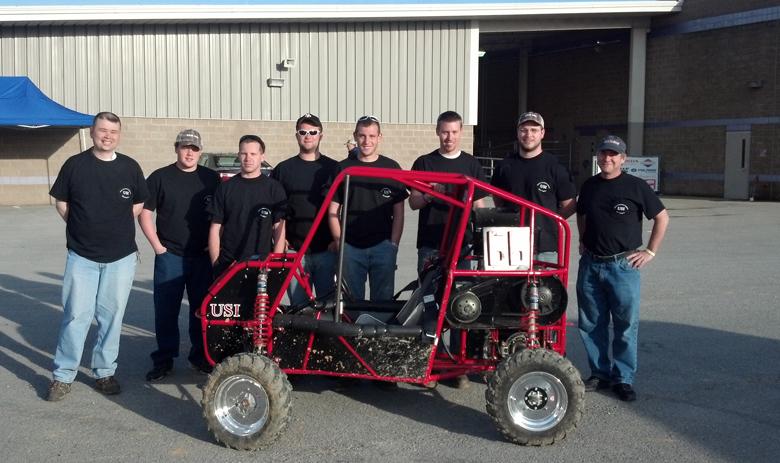Building a car from scratch is something not a lot of people get to experience.
But for USI’s chapter of the Society of Automotive Engineers, preparing for the mini-baja car race is an annual event.
The team is updating its one passenger, off-road vehicle for next summer’s race, as well as training new members.
In the winter, they will begin designing the car for next year’s race.
When the students begin making adjustments, Faculty Adviser Julian Davis encourages them to look at the previous year’s designs to see the changes that were made, why they were made and how the changes affected the race.
“(Designing the car) is all on them,” Davis said. “There are certain rules and regulations that they have to follow. There’s a 60 to 90 page book basically of the rules they have to follow, and they have certain design considerations that they have to follow.”
The students have a few freedoms when it comes to design, though.
The cars can vary from small to large, depending on what race or division the students want to focus on winning.
The races includes a rock crawl, maneuverability test, acceleration, stud pull, an endurance race and occasionally, a flotation event.
Davis puts his experience in finite modeling to good use, helping the students test the baja car’s geometry and mechanics.
The finite element package calculates the loads, and is cheaper than building a living model to test the car.
Davis uses baja car problems in his finite modeling class, too.
“That’s one of the unique things about the baja car,” David said. “There are some really interesting problems that they can’t solve that are not necessarily book problems, so you help the student formulate the problem statement and step through it, and that’s really a lot of fun.”
Every team uses the same ten horse power Briggs and Stratton motor, which is shipped to the participating school after the registration fee is paid. The engine comes equipped with a governor, a device that controls the power of the engine to keep it the same for every team.
The same car can be used for three years.
There is an inspection of all of the cars before the race begins.
“They make you write down all your technical specifications then, if you place in the top five, they tear your car apart to make sure your car hasn’t been changed since the inspection,” said Ryan Elpers, USI’s SAE Mini-Baja Club president.
If something breaks in the three-hour endurance race, it can be fixed.
USI’s team plans to make an extra axel in case one breaks like it did this year, Eplers said.
The number on the car depends on how the team ranked the previous year.
USI raced as number 66 this year and will race as number 38 next year.
“It’s really fun and not a lot of people get the chance to take a car from raw metal to a fully operational car,” Davis said. “That’s quite unique, especially with the facilities that we have. We hope to take advantage of all the new machines that we have up there (in the Applied Engineering Center) to help us build a structurally better car.”
The students take the lead when it comes to building and designing the car, said Davis, who relies more on the students than the students rely on him.
“It’s about working on something,” he said. “It’s about working with other people. It’s about taking a project from start to finish. I think that’s something employers really want to see.”



